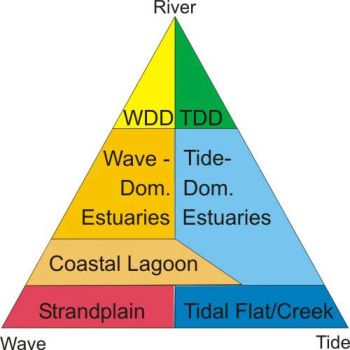The broad diversity of Australian estuaries means that it is often necessary to divide them into ‘groups’ or ‘types’ which are more closely related to one another. This may be done for a number of reasons, including the identification of estuaries for uniqueness within a catchment or conservation estate, for the identification of monitoring needs, for management purposes, etc.
Currently there is no comprehensive typology of Australian estuaries, however, the geomorphic classification presented here is a initial start and is currently the national default typology.
Geomorphology (or the study of the nature and history of landforms and the processes which create them) is an easily recognisable end product of a combination of environmental factors. Under stable tectonic and sea level conditions, the gross geomorphology of coastal waterways is principally determined by the relative influence of wave, tide, and river power (figure 1; Boyd et al., 1992, Dalrymple et al., 1992), with each coastal waterway containing a distinctive suite of geomorphic and sedimentary environments.

Figure 1. Ternary classification of coastal systems are divided into seven classes (after Dalrymple et al., 1992, Boyd et al., 1992). The position of each coastal waterway type depends on the relative influence of waves, tides, and rivers. Embayments and drowned river valleys are omitted from the diagram as they represent ‘immature’ coastal waterways (or coastal waterways which are not significantly filled with sediment). WDD = wave-dominated deltas, and TDD = tide-dominated deltas.
During the National Land and Water Resources Audit (NLWRA), Geoscience Australia analysed aerial photographs, Landsat TM imagery, scientific literature, and compiled data for wave, tide and river power to create a comprehensive Australia-wide classification of estuaries and coastal waterways. The seven key waterway types were identified using this systematic and quantitative geomorphological approach. The distribution of each type of coastal waterway around the Australian coastline is shown below.
Classifications and generalisations
The distribution of these different coastal waterway classes around the Australian coastline displays a distinct zonation, such that five major coastal regions can be identified. These include:
- North-east coast
- South-east coast
- Great Australian Bight
- South-west coast
- North-west coast
- Gulf of Carpentaria
The southern regions are wave-dominated environments, whereas the northern coastal regions are mainly tide-dominated. This pattern conforms to the general distribution of wave- and tide-dominated shelf environments (Harris et al., 2002). However, each of the five coastal regions contains a mixture of coastal depositional environments.
Geomorphic classification schemes that are to be used at a national or regional level also need to recognise environmental parameters that are not strongly reflected in morphology alone, such as variations in climate, vegetation, and other biological aspects. In the development of the conceptual models, linkages are made between the geomorphic classification (Harris et al., 2002), and previous schemes that classify the coastline in terms of climate and rainfall (Heggie et al., 1999b). In order to account for seasonality and climatic variation in the estuarine conceptual models, both positive (freshwater-dominated) and negative (evaporation-dominated) hydrodynamic examples of tide-and wave-dominated estuaries have been developed.
Climate and seasonality
In strongly seasonal areas that alternate between relatively high runoff and arid conditions (e.g. the wet/dry tropical climatic zone), the relevant conceptual model varies between the two climatic extremes. For example, in the moist tropical climatic region, a waterway that exhibits the hydrodynamic function of a tide-dominated estuary during the wet season, may exhibit the hydrodynamic function of a tidal creek (no freshwater runoff) during the dry season. Alternatively, during the dry season, the waterway may function as a ‘negative’ tide-dominated estuary, due to higher rates of evaporation (Heggie et al., 1999b).
More information about climate and seasonality or climate variance.


